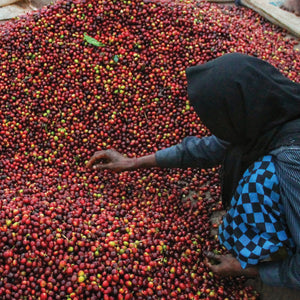Post-harvest processing
We are a land of farms and a country of agriculturists. Agriculture is the most common occupation across the country. Ever wondered what’s the innovation a farmer would be doing at their level ? yes, multi-crop agriculture, sustainable farm practices and so on.. but also, a key role that farmers today play is at the post-harvest stage. Upon harvest, the pickers usually bring the coffee cherries to the yard and their duty is over. Now it is upto the planter to innovate and take the pulping/drying of coffee cherries to develop natural flavours in the beans.
Pulped sun dried coffees or sometimes called honey sun dried coffees do not mean they are coated with honey. It’s in reference to the mucilage over coffee beans that remains after pulping the cherry. Pulping happens in pulping units using machinery or rarely using hand. After pulping, the sticky substance that coats coffee beans are left to dry in the sun. Eventually this turns into a patchy yellow, red, brown or black color depending on the heat it is exposed to and the number of days it is exposed to the sun.
There’s another process of leaving cherries in the sun and letting them dry with beans intact inside the fruit. Once it is completely dry, they are hulled in machinery and the beans are then stored carefully. These are usually termed as naturally processed coffees. They’re typically more sweet and contain complex notes.
There’s the basic method of plucking cherries, pulping them and immediately washing them thoroughly to reach the green bean. This is the most common method of processing coffee beans after harvest. The beans bear optimum amounts of flavours and acidity.
Now, there’s people like us, around the world who are working with planters and innovating with post-harvest processes and introducing different yeasts to the fermentation of coffee fruits and sometimes pulped beans. There’s a huge scope for what all factors of a coffee bean can be enhanced during the post-harvest processing stage. This also helps us achieve really different flavours in coffee beans which we otherwise wouldn’t have been able to bring out.


